Publications Analysis
Autism Spectrum Disorder Research
The Global Landscape of Autism Research
2012
As discussed in the introduction, there are many aspects of autism in need of more research. The research topics of highest priority to the IACC are those set forth in the seven chapters/Critical Questions of the IACC Strategic Plan (described in Figure 1). To describe the nature of research being published in autism, publications were classified by how they best aligned with the IACC Strategic Plan. First, all 2010 publications were categorized manually into one of the seven Critical Question areas outlined in the Strategic Plan. Although some publications naturally span multiple areas of research, each publication was assigned to only one category to facilitate tracking and trend analyses. Given the large number (25,137) of autism-related research articles published in the last 30 years, the results of the manual categorization were used to design a customized automated categorization tool to classify each of 1980-2009 publications into the one most closely matched research category (see Research Methods in the Introduction and Appendix II for more details).
To begin, themes related to each of the Critical Question research areas are described in order to provide a picture of the amount and types of autism research being conducted. Next, the volume and relative proportions of 2010 publications in each of the Critical Question research areas is examined. Finally, results are provided from an analysis of how these research topics and total autism research more generally have grown and evolved over the last 30 years.
What research themes are prominent in autism publications?
Examination of frequently used words in publication text can be helpful in identifying key research themes. This approach was used to identify key themes in autism research articles published between 1980 and 2010. Based on the text of autism-relevant publications, Figure 5 shows a word cloud composed of the most prevalent words used across all publications (in dark gray), as well as the top 15 unique descriptive words that appeared most often in the respective Critical Question area publications. Words that are larger in the cloud appear more frequently in the various text categories. These descriptive terms provide a snapshot of the most prominent research themes in autism publications and how they vary across the different Critical Question areas.
Autism Publications Word Cloud
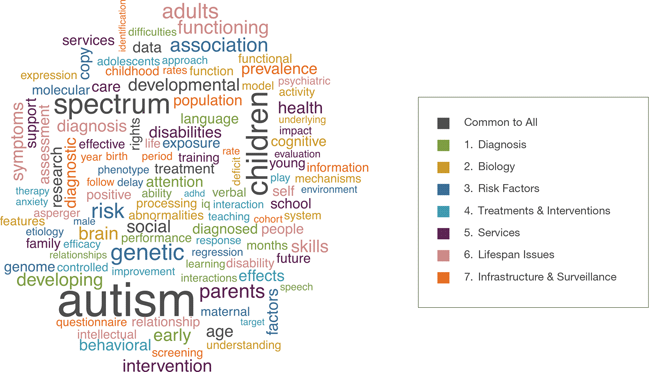
Figure 5. Autism Publications Word Cloud. This word cloud shows frequently used words in autism research publications from 1980 to 2010. The top ten most prevalent and descriptive words across all autism publications are shown in dark gray, and the top 15 most frequently used words appearing in publications pertaining to each Critical Question area of the IACC Strategic Plan are color-coded according to the key to the right. The larger the font size, the more often the word appeared in the various text categories.
How were 2010 publications distributed across IACC Strategic Plan Critical Question areas?
Figure 6 shows the distribution of 2010 primary research publications across the seven IACC Strategic Plan Critical Question areas. This analysis was limited to primary research as this category is most indicative of novel research findings (see Appendix I for how primary research was identified). The research area with the most primary research publications was Biology, followed by Treatments and Interventions and then Risk Factors. Comparatively less research was published in the Services, Lifespan Issues, and Infrastructure and Surveillance areas. This distribution pattern fits with what is known about several factors that may influence publications in the ASD research field. A discussion of factors that likely contribute to variation in Critical Question area publication output follows at the end of Chapter One in the section, Which Critical Question research areas are showing the strongest growth?
Distribution of 2010 Primary Research Publications within the Seven Critical Question Areas of the IACC Strategic Plan
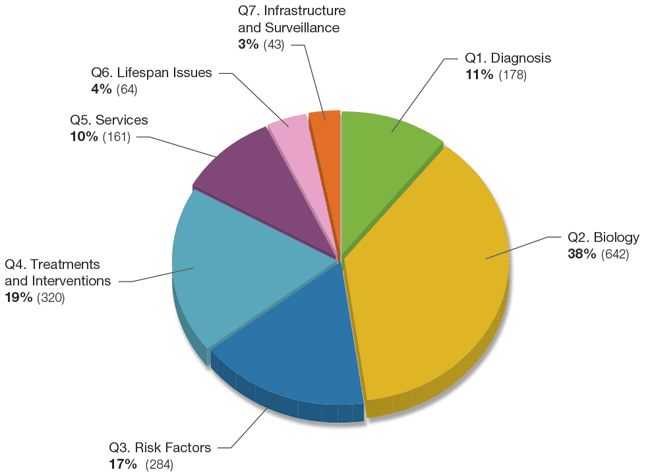
Figure 6. Distribution of 2010 Primary Research Publications within the Seven Critical Question Areas of the IACC Strategic Plan. The number of primary research publications categorized into each Critical Question area is shown in parentheses and the proportion of total publications is shown as a percentage. The total number of 2010 autism primary research publications with available abstract text for categorization was 1,692. Percentages add up to more than 100% due to rounding.
How much has autism research grown?
Taking a high-level view of autism research publications across the last 30 years, the overall rate of publication growth was analyzed and publication trends examined for each Critical Question research area. Using the approach described in the Research Methods section, ASD research papers published during the time frame of 1980 through 2010 were identified, and the total number of publications for each year was determined. Figure 7 shows the total number of ASD publications for each year analyzed (blue line). In 1980, approximately 200 journal articles addressing autism research topics were published. By 2010, the number of autism publications had grown to more than 2,400 per year, representing 12-fold growth in the annual publication output across the last 30 years.
Growth in ASD-related Publications, 1980 to 2010
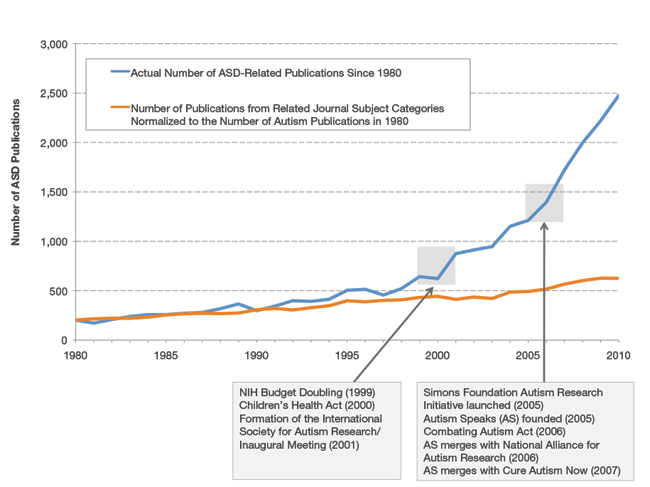
Figure 7. Growth in ASD-related Publications, 1980 to 2010. The number of autism publications increased dramatically between 1980 and 2010, with a rapid rise in autism research publication rates beginning around 2000 (blue line). The line indicating the expected growth of autism publications in this time frame (orange) is based on a comparison group of publications in the same Journal Subject Categories which comprise over 75% of ASD publications (1980 to 2010). Gray squares highlight the time frames of 1999 to 2001 and 2005 to 2007. Listed below the graph are some of the key events that took place during these time frames. A more complete description of these events is provided in the corresponding text.
Overall, scientific research output has experienced an upward trajectory for decades. To compare whether the growth of ASD publications from 1980 through 2010 was above or below that of comparable research fields, the growth of ASD research publications was compared to growth observed in all publications included in twelve Web of Science® Journal Subject Categories in which ASD-related articles were most frequently found. The Journal Subject Categories are part of a thematic classification scheme where publications with similar research topics are grouped together according to the journal in which they were published. Among the 25,137 ASD-related publications collected for the years 1980 to 2010, over 75% fell into twelve Journal Subject Categories: 1) Psychology, Developmental; 2) Psychiatry; 3) Neurosciences; 4) Clinical Neurology; 5) Rehabilitation; 6) Pediatrics; 7) Genetics & Heredity; 8) Education, Special; 9) Psychology, Clinical; 10) Psychology; 11) Behavioral Sciences; and 12) Psychology, Experimental. A similar distribution was also seen for the 2010 ASD publication subset. See Appendix III for the specific breakdown of autism publications into these Journal Subject Categories.
The orange line in Figure 7 represents the number of publications across these broader Journal Subject Categories normalized to the number of ASD-related publications in 1980 to facilitate the comparison of their relative growths (for a detailed explanation of normalization methodology, see Appendix III). While the ASD publication growth matched the broader publication growth from 1980 to 1998, there has been a sharp increase in ASD publications since 1999, far outpacing the combined growth rate of publications in the 12 related Journal Subject Categories in the same time period.
Growth in the field is likely attributable to increased awareness of and appreciation for the societal impact of autism spectrum disorders. The timeline in Figure 7 highlights some recent events that may have contributed to the observed growth in autism research, especially in the period from 1999 to 2010. In 1999, Congress began an effort to double the annual budget of the NIH, the largest individual funding source for autism research worldwide. Moreover, the amount of NIH funding devoted to autism-related research projects increased from $40 million in 1999 to $169 million in 2011, a more than 4-fold increase.ii
In 2000, the Children's Health Act (CHA) (PDF – 546 KB) was signed into law, which established an earlier version of the IACC, called for the NIH to establish centers of excellence in autism research, and strengthened Federal autism surveillance activities to track the prevalence of autism across the US.iii In 2001, the International Society for Autism Research (INSAR) was formed to unite autism researchers across many disciplines to accelerate research progress. INSAR held its inaugural scientific conference, the first to be solely dedicated to autism research, in 2001 and now annually convenes almost 2,000 autism researchers and practitioners from around the world to collectively address the most critical questions in autism research.
In 2006, Congress enacted the Combating Autism Act (CAA) to continue and increase the Federal autism activities set forth by the CHA. In the last decade, several private research foundations and non-profit organizations have also made major contributions to autism research. The Simons Foundation Autism Research Initiative (SFARI) was launched in 2005 and currently provides more than $50 million a year in autism research grants. Founded in 2005, Autism Speaks became the world's largest autism science and advocacy organization after merging with the National Alliance for Autism Research (NAAR) in 2006 and Cure Autism Now (CAN) in 2007. They fund a broad range of autism research grants annually, including biomedical and services research, and play a critical role in raising support and awareness for autism research worldwide.
Which Critical Question research areas are showing the strongest growth?
The automated categorization tool was applied to autism journal articles published from 1980 to 2009 to determine the number of publications per year within each Critical Question area of the IACC Strategic Plan (see Figure 1 for a description of the Critical Question areas and related research topics). Figure 8 shows 5-year averages plotted from 1981 to 2010 for each Critical Question area. In general, the trends in the distribution of publications among the seven Critical Question research areas have remained consistent since the 1980s. Research focused on the underlying Biology of autism has consistently accounted for the largest segment of publications, followed by research on Treatments and Interventions and Risk Factors. Through the years, Lifespan Issues and Infrastructure and Surveillance have been the research areas with the smallest number of associated articles.
Growth in ASD Research Publications by Critical Question Area within the IACC Strategic Plan, 1981 to 2010
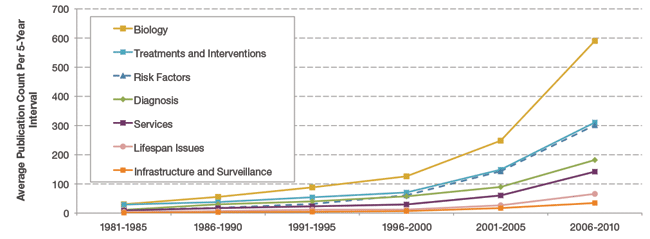
Figure 8. Growth in ASD Research Publications by Critical Question Area within the IACC Strategic Plan, 1981 to 2010. The growth trends in the Critical Question areas of autism research over the past 30 years illustrate that Biology has long been a strong component of autism research, followed by Treatments and Interventions and Risk Factors. Each data point represents a five-year average of the number of annual autism publications. Publications in this figure include both primary and secondary research. See Figure A-27 in Appendix I for publication output by primary research only.
This distribution of research publications across the seven Critical Question areas mirrors the distribution of research funding across these areas as identified by the 2008, 2009, and 2010 IACC ASD Research Portfolio Analysis Reports.6,7,8 For example, Biology was expected to have the greatest concentration of research publications because data presented in the annual IACC Portfolio Analysis has shown this area to be one of the largest areas of funder investment in recent years. The greater number of publications in this area may also be indicative of the relatively early stage of development of the autism research field, as a strong emphasis on research to understand the underlying biology of diseases and disorders can result in foundational discoveries necessary to support and inform research in more clinical and translational scientific areas such as Diagnosis and Treatments and Interventions.
The relative differences observed in publication output between the Critical Question areas can be explained partly by the cultures of different research disciplines. For example, basic biological and biomedical research tends to emphasize publication of data as a measure of success, whereas some research in the Services area, which may include topics such as assessment of new services, practitioner training approaches, or evidence dissemination efforts, is less likely to be published in research journals. Certain other Critical Question areas were also expected to have less research activity, including Lifespan Issues, which includes a focused subset of biomedical and services research relevant specifically to adults on the spectrum. The proportion of publications in Infrastructure and Surveillance was also likely to be small because most infrastructure investments, such as research facilities and training programs, result in publications better classified in one of the other research categories rather than in "infrastructure." Most of the publications in the Infrastructure and Surveillance research area are related to ASD surveillance.
Recent Critical Question growth trends were examined in greater detail. Figure 9 (top left) shows the annual volume of research publications in each Critical Question area since 2000, the year in which the autism publication rate began to dramatically increase. Figure 9 (bottom right) shows the overall growth rate since the year 2000, depicted as fold growth. While Biology has the largest proportion of publications each year and has demonstrated substantial fold growth from 2000 to 2010, the smaller categories of Infrastructure and Surveillance, Services, and Lifespan Issues have grown at least as much since 2000. Statistical analyses were run to determine if any Critical Question growth rates were significantly different from the others. The Critical Question areas with the 3 highest fold growth values—Infrastructure and Surveillance, Services, and Lifespan Issues—grew at significantly faster rates than Diagnosis and Risk Factors publications but are not statistically different compared to Biology or Treatments and Interventions. Further investment and focused research are needed to catalyze continued growth in all Critical Question areas.
Number and Fold Growth of ASD Publications from 2000 to 2010
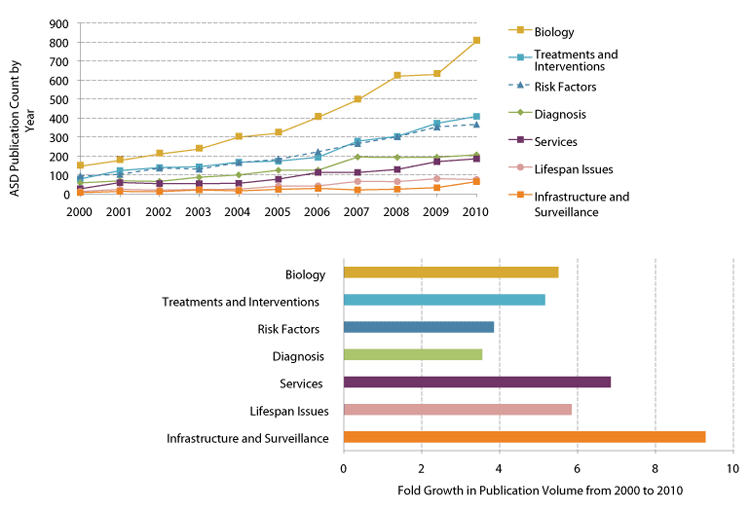
Figure 9. Number and Fold Growth of ASD Publications from 2000 to 2010. This figure illustrates number (top left) and fold growth (bottom right) of research publications within the respective strategic areas since 2000. Recent growth trends in strategic areas of autism research show that while Biology maintains the largest proportion of publications, other areas are growing at least as quickly, including Infrastructure and Surveillance, Services, and Lifespan Issues. Publications in this figure include both primary and secondary research. See Figure A-28 in Appendix I for publication output and fold growth by primary research only.
Main findings from analysis of trends in autism research topics and publications:
- The IACC Strategic Plan areas of Biology, Treatments and Interventions, and Risk Factors have the highest number of total publications in each year from 1980 to 2010.
- The overall number of autism research articles published each year – in all Critical Question areas combined – has grown 12-fold since 1980.
- The rapid growth in autism research publications since 2000 far outpaces that observed in comparable research fields.
- All IACC Strategic Plan Critical Question areas have demonstrated pronounced growth in rate of publication since 2000, including the areas with the smallest number of publications: Infrastructure and Surveillance, Services, and Lifespan Issues.
Spotlight on Risk Factor Research
Publication Output and Trends in Subcategories of Autism Risk Factor Research
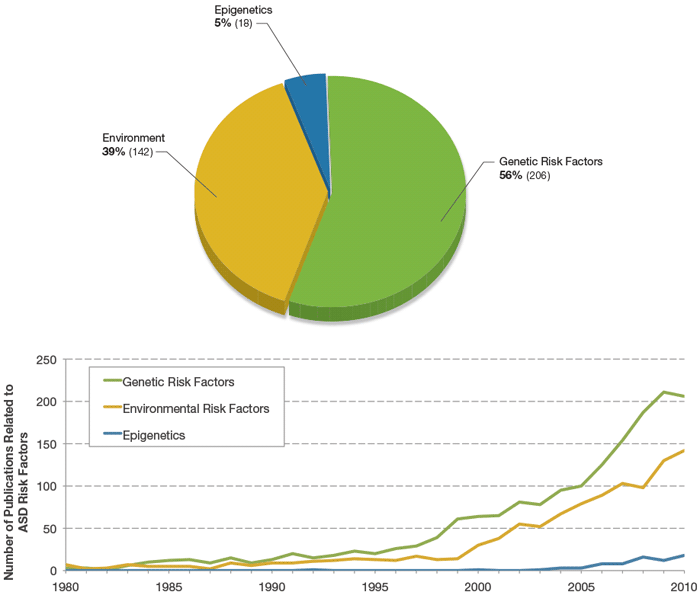
Figure 10. Publication Output and Trends in Subcategories of Autism Risk Factor Research. The pie graph (top) illustrates relative proportions of research articles published in 2010 in three subcategories of ASD risk factor research and the line graph (bottom) shows the increase in number of publications in each subcategory over time from 1980 to 2010. Genetic Risk Factors research had the greatest number and proportion of publications, while the emerging field of Epigenetics had the smallest number and proportion of publications. The number of publications in each subcategory has been increasing over time, especially since 1999 for Genetic Risk Factors and Environmental Risk Factors and since 2006 for Epigenetics. Publications in this figure include both primary and secondary research. See Figure A-29 in Appendix I for publication output by primary research only.
With 1 in 88 children affected by autism, the patient and research communities feel a sense of urgency to identify risk factors that may be contributing to the rise in autism prevalence. Autism risk factor research has yielded some strong leads, but much work remains to identify a more complete picture of the risk factors that play the most significant role in the development of autism. Scientific evidence suggests that genetic and environmental risk factors form a complex web of interactions that determine whether a person develops an autism spectrum disorder.
To provide a clearer picture of research on autism risk factors, risk factor research publications were further classified into three subcategories:
- Genetic Risk Factors: This research includes efforts to identify new genes that are implicated in increased risk for ASD or to better understand previously identified genetic risk factors. Since the completion of the human genome map in 2003, scientists have identified a flood of genetic mutations that contribute to a variety of human diseases and disorders, and a few hundred genes have been implicated in autism.9,10,11 Some individuals on the autism spectrum have syndromes that result from single gene mutations, such as fragile X, tuberous sclerosis, and Rett syndrome; however, it is estimated that single gene disorders may only account for ~10-20% of all autism cases.12 The majority of the genetic mutations and alterations identified to date have much more subtle effects, individually accounting for only a small increase in risk.
- Environmental Risk Factors, including studies on the interaction of genes with the environment:iv Researchers are actively searching for pre- and postnatal environmental risk factors, either alone or in combination with genetic susceptibility (gene-environment).13 Some examples of environmental factors currently being explored in autism risk factor research include maternal dietary factors, maternal medications taken during pregnancy, child and maternal response to immune challenges and infection, environmental contaminants and toxins, as well as social changes in reproductive patterns and parental age. Environmental factors can interact with genetic factors in numerous ways. For example, they can cause novel mutations called de novo mutations in parents' germ line DNA. These molecular events can significantly affect development at various points throughout the lifespan.
- Epigenetic Processes: Epigenetics, an emerging area of research, is the study of heritable changes in gene function (such as methylation of DNA) that occur without changes to the DNA sequence. Environmental factors can alter epigenetic processes by affecting the molecules that bind DNA and control gene function. These epigenetic changes can be passed along from one generation to the next and have far-ranging biological consequences, potentially contributing to autism risk.14,15
In this analysis, which includes both primary and secondary research publications, Genetic Risk Factor publications comprised the largest share of 2010 publications (56%), followed by Environment (39%) and Epigenetics (5%). Major upturns in both Genetic and Environmental research have occurred in the last decade. An appreciable increase in genetics publications can be seen around 1998, and the field has matured since 2000, with large-scale genetics research now commonplace in the autism field. Environmental Risk Factor research is somewhat less established, but it has acquired substantial momentum over the last decade. Due to the relative youth of the Epigenetics research field in general, research on the role of epigenetics in autism has only emerged in the last few years, and represents a growing area of autism science. Very similar trends were observed when publication output analysis was restricted to primary research publications only. See Figure A-29 in Appendix I for more details. It will be important to continue to track developments in risk factors research to see if current trends continue or new research areas emerge.




